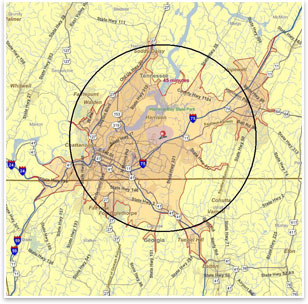Sustainable Design Assessment Team Aims for Green in Tennessee
by Russell Boniface
Associate Editor
 How do you . . . create and maintain sustainable growth within a region? How do you . . . create and maintain sustainable growth within a region?
Summary: The AIA Communities by Design’s Sustainable Design Assessment Team (SDAT) is working on a project study in Chattanooga to transform the landscape and functionality of the region over the next decade. The project is called Southeast Tennessee Valley. SDAT programs bring together architects and other professionals to provide a plan for communities seeking to improve sustainability.
You will find a link to 50 to 50 on AIA.org.
1.The project study focuses on creating and maintaining quality of life and sustainable growth in the region with an emphasis on refocusing the local zoning ordinances and subdivision rules and regulations.
2.Chattanooga is the center of a metropolitan region with over 450,000 people and a trading area of over one million.
View this week in pictures.
Chattanooga is the center of a metropolitan region with over 450,000 people and a trading area of over one million. The SDAT project study is pursuing the sustainable development and growth of the Southeast Tennessee Valley region around Chattanooga. The study has two major challenges over the next decade. The first of these challenges is the construction and operation of a new Volkswagen manufacturing facility, which will create 2,000 jobs. This is the main focus of the project study, and construction on the Volkswagen facility has recently begun, with production expected to begin at 2011. The second challenge is meeting the U.S. Council of Mayors Climate Protection Agreement, signed in 2006 by Chattanooga Mayor Ron Littlefield.
The project study focuses on creating and maintaining quality of life and sustainable growth in the region with an emphasis on refocusing the local zoning ordinances and subdivision rules and regulations. The region to be studied includes seven counties—three in Tennessee and four in Georgia. Sustainable growth would address community issues in quality of life and growth. The project goals are: continue to allow food to be grown locally; clean surface water and recharge storm water runoff; conserve water due to recent regional drought conditions; provide for multiple mass transportation options; reduce air pollutants; create convenient and cost effective recycling solutions; define appropriate building zones; plan for open space and parkland; and promote energy efficiency.
SDAT study linked to Climate Protection Agreement
Steve Haase, AIA, LEED AP, of Chattanooga-based franklin|architects, is the chairman of the steering committee on the project, and was president of AIA Chattanooga when the SDAT announcement came out. Haase says the SDAT project study was linked from the beginning to the Climate Protection Agreement.
“I made an announcement in 2006 at our monthly meeting and ended up with eight architects and regional planners who were interested,” Haase says. “We thought it would be a good idea to explore. We had a brainstorming session and invited people to join us. There wasn’t time, however, to get a proposal together. But this past June I sent a notice that we would meet to get out a proposal.”
Once Volkswagen made the announcement it was going to create a new manufacturing facility, Haase and team thought it was a perfect opportunity to generate its proposal, with the Volkswagen facility being the focus of the project study. “We just had to put parameters on it,” Haase recalls. “We wanted to make sure that if the proposal was accepted, whoever came to town would know that the city of Chattanooga and the region had signed the mayor’s Climate Protection Agreement. We wanted to make sure that any recommendations factored that into the equation.”
 Haase cites auto manufacturing plants in Greenville, S.C., and Spring Hill, Tenn., as projects that have grown beyond what was envisioned over 10 years ago. “While Volkswagen will create 2,000 jobs, there will be other jobs, such as suppliers, associated with the overall growth. It becomes an exponential growth equation. For every worker at the Volkswagen plant you end up with another three-and-a-half workers within the region.” Haase cites auto manufacturing plants in Greenville, S.C., and Spring Hill, Tenn., as projects that have grown beyond what was envisioned over 10 years ago. “While Volkswagen will create 2,000 jobs, there will be other jobs, such as suppliers, associated with the overall growth. It becomes an exponential growth equation. For every worker at the Volkswagen plant you end up with another three-and-a-half workers within the region.”
Haase believes the issues that the SDAT project study are going to address will reduce the region’s greenhouse gas emissions. “I don’t know that it will help us get down to levels that the Climate Protection Agreement states because we are going to be growing by adding jobs and facilities, but at the same time we need to be reducing our greenhouse gas emissions,” he says. “But letting the community grow while reducing greenhouse emissions will be a challenge."
|



